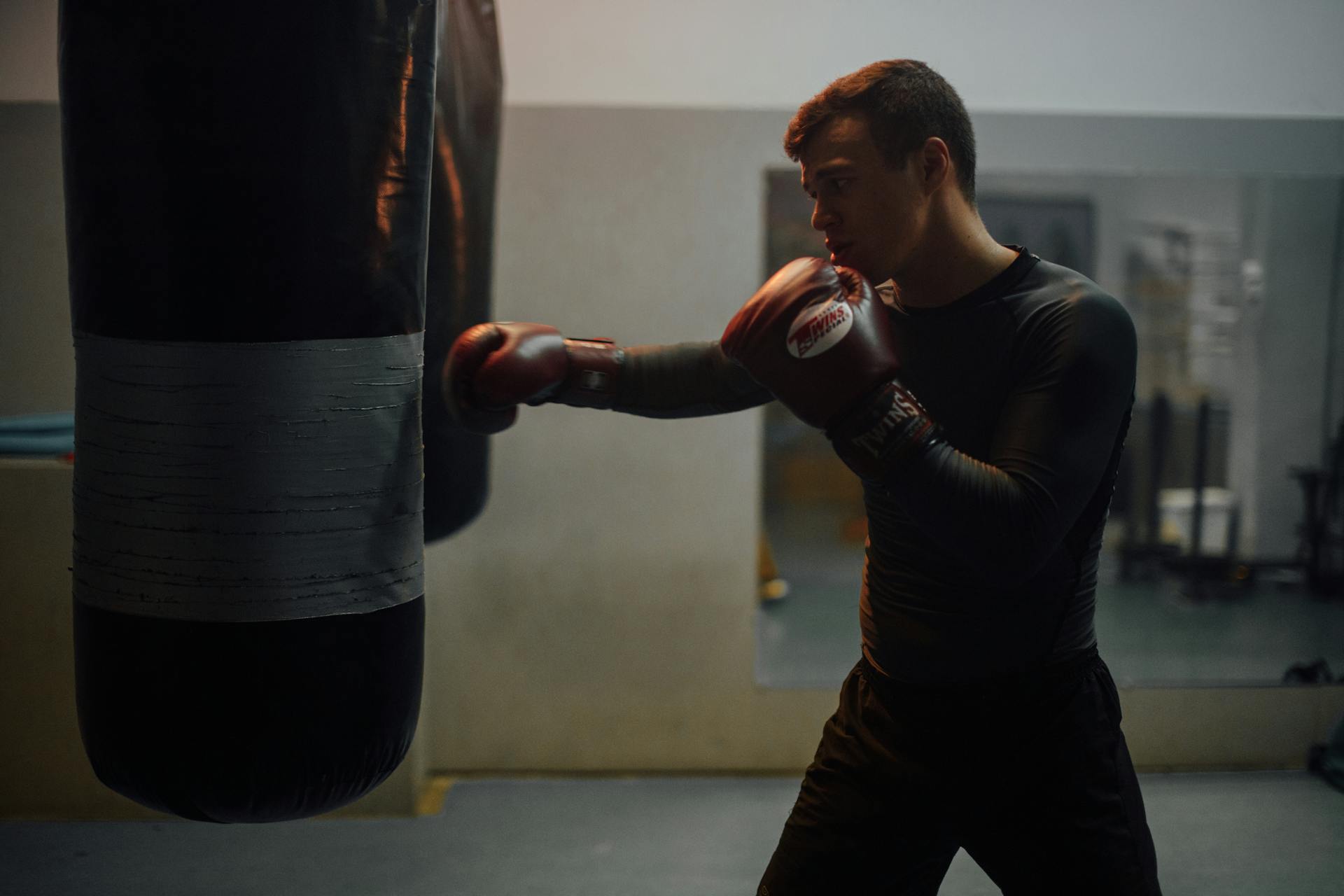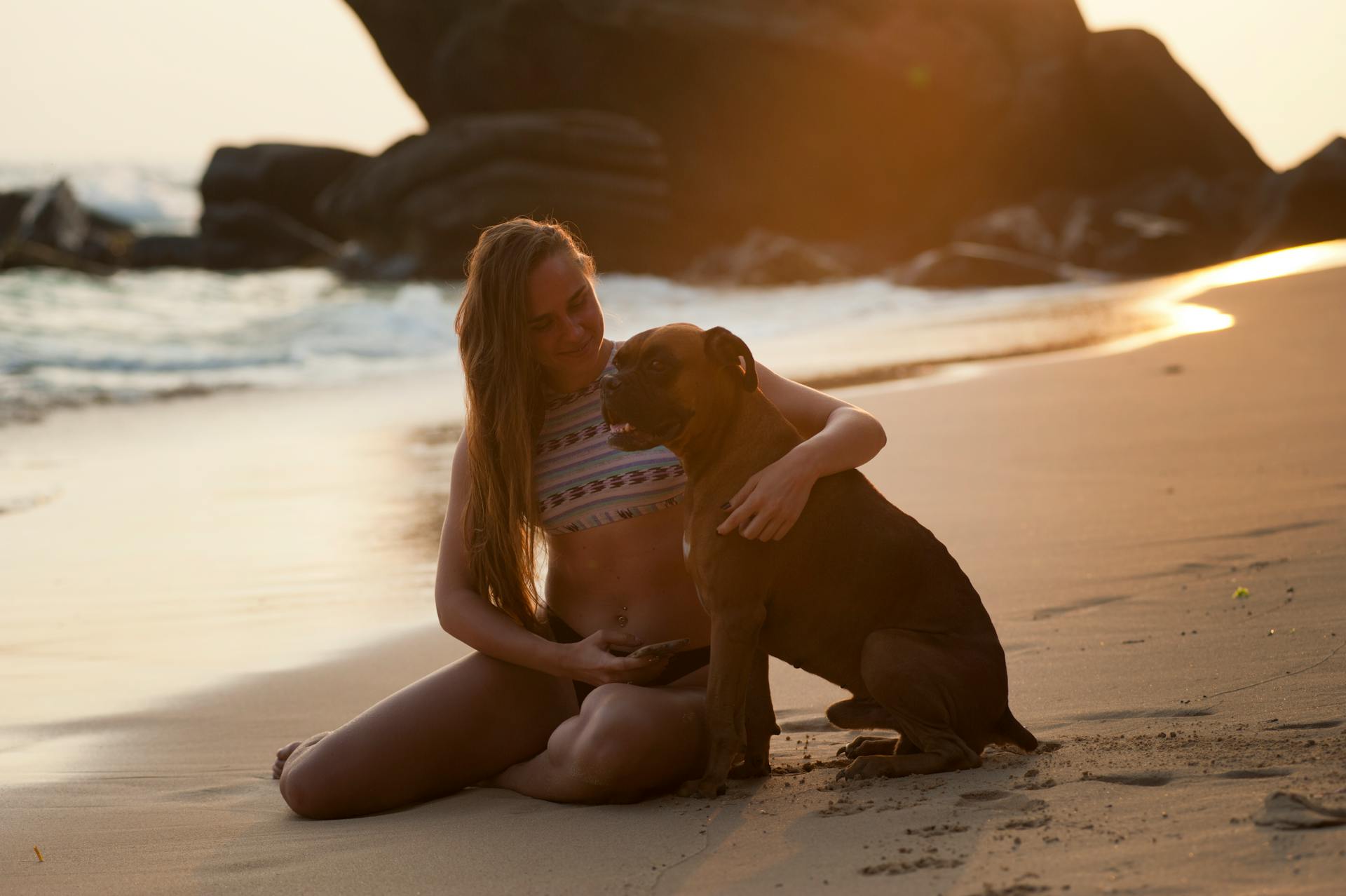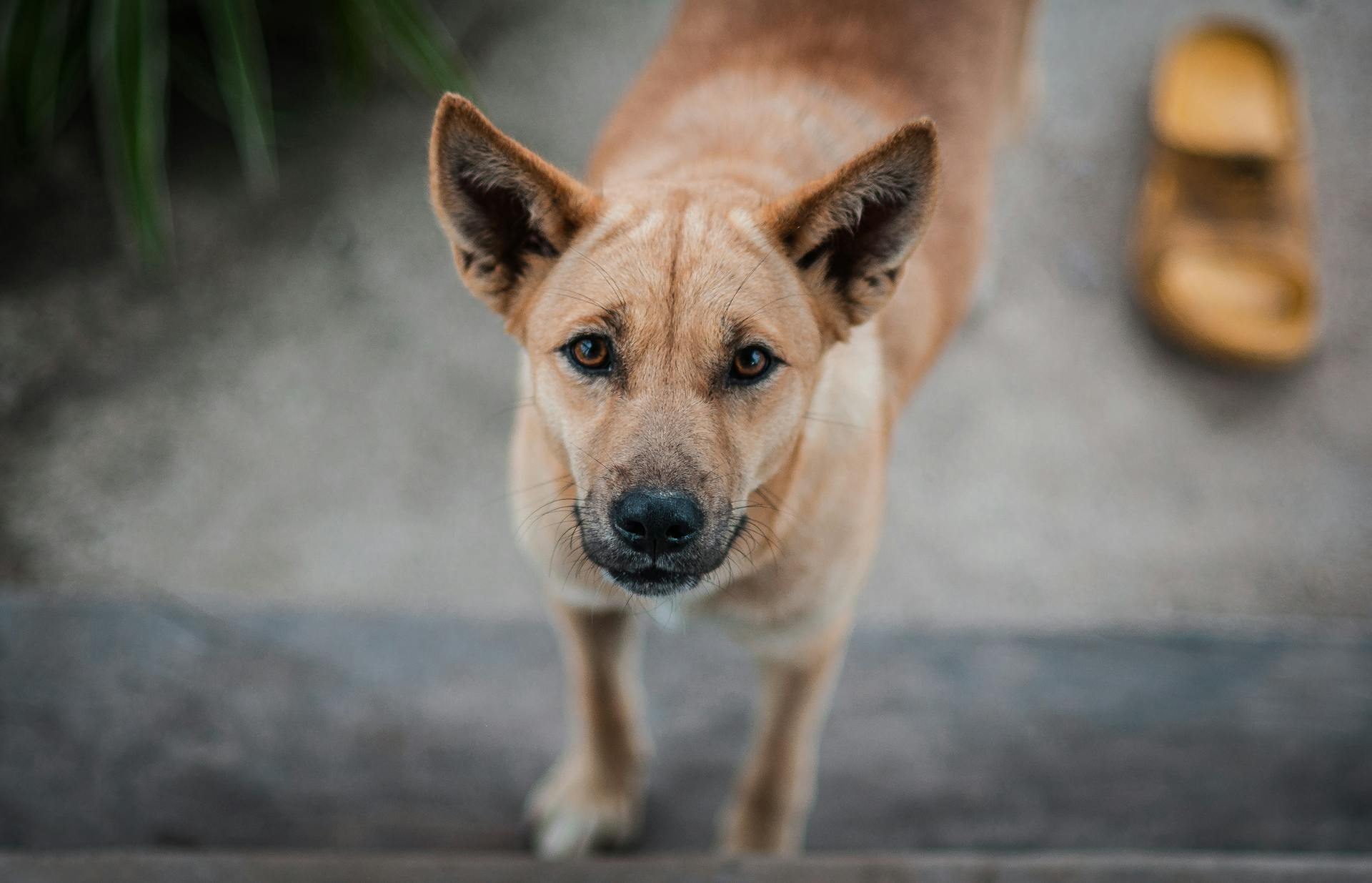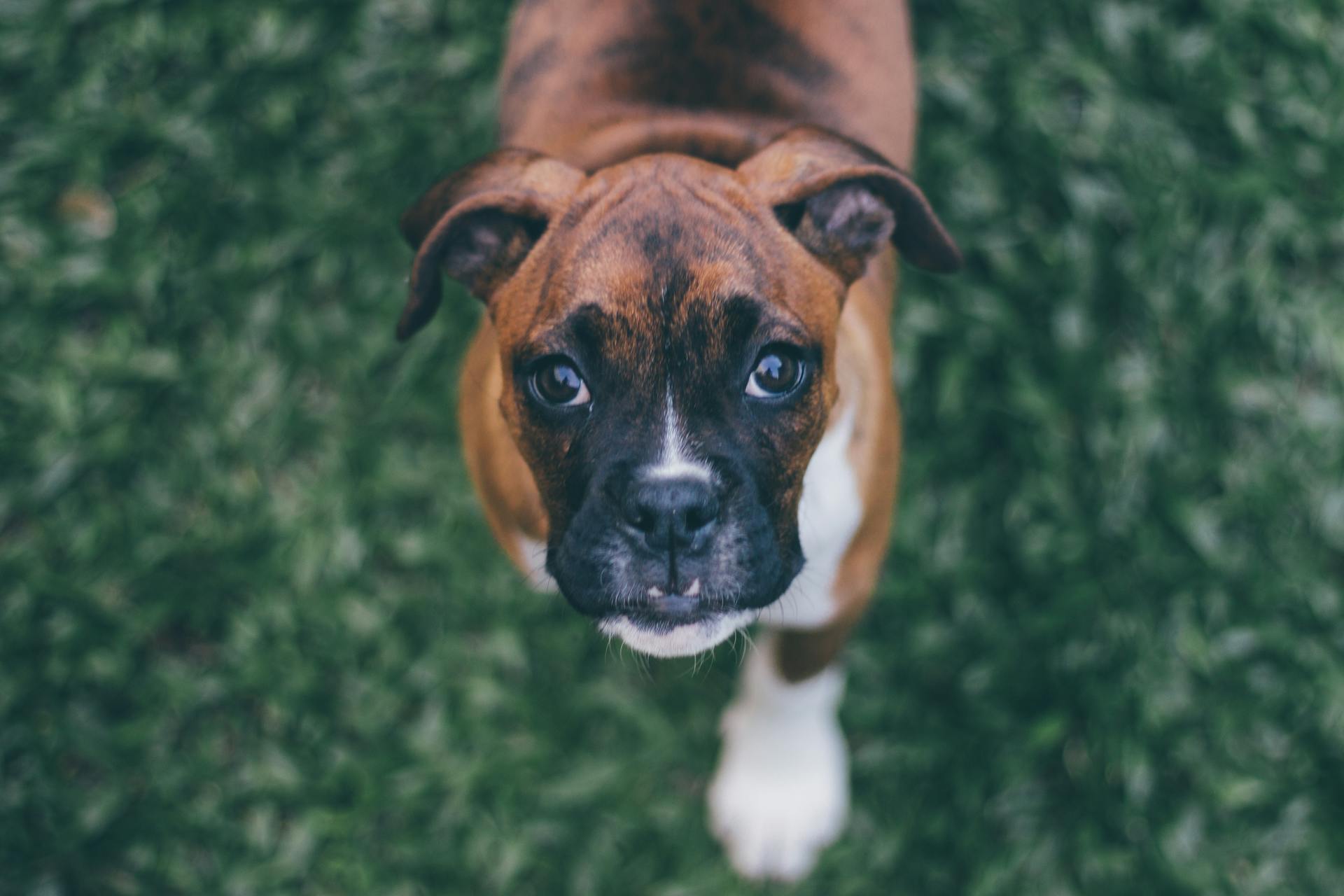
Boxer dogs are energetic and playful companions that thrive on structure and clear communication. They are highly intelligent and eager to please, making them a joy to train.
To start training your boxer, establish a routine that includes regular exercise and playtime. Boxers need at least 30 minutes of physical activity daily, which can include walks, runs, and playtime in the yard. Consistency is key when training a boxer, so stick to a schedule and make sure all family members are on the same page.
Housebreaking is a crucial part of boxer training, and it's essential to start early. Boxers are naturally clean animals and will learn to go potty outside with positive reinforcement and patience.
Check this out: Starting a Dog Training Business
Socialization and Training Basics
Socialization and training are crucial for Boxer puppies from the get-go. Socialization begins the moment the puppy enters their new home, and it's essential to introduce them to friendly people and pets properly.
If this caught your attention, see: Dog Socialization Training
It's recommended to enroll in the AKC Family Dog Program, which is a great way to socialize your pooch. Most training clubs allow puppies as young as eight weeks old to enroll if you provide proof of the dog's first shots.
Consistency is key when it comes to training Boxers. They love to learn but can be stubborn and respond best to reward-based positive reinforcement training. Yummy rewards like small pieces of chicken or hot dog work best.
Boxers are bright and energetic, so start teaching them basic obedience commands like 'Sit,' 'Stay,' and 'Come' immediately after bringing them home. The more you train Boxers, the better they'll be and the less chance they'll get bored and destructive.
Here are some tips to keep in mind when training your Boxer puppy:
- Start training as soon as possible, even from the moment the puppy enters their new home.
- Enroll in the AKC Family Dog Program for socialization.
- Use reward-based positive reinforcement training.
- Teach basic obedience commands like 'Sit,' 'Stay,' and 'Come' immediately.
Advanced Training and Commands
Once your Boxer has mastered the basics, it's time to take their training to the next level with advanced commands.
Boxers are whip-smart and energetic, making them perfect candidates for learning new tricks. Teaching them advanced commands is a great way to channel their boundless energy.
To prevent your Boxer from making a run for it while in your yard, even if it's fenced, ensure they know the "Stay" and "Come" commands reliably.
The AKC Canine Good Citizen Program is an excellent way to take your Boxer's training to the next level, and the AKC S.T.A.R. Program is a great place to start.
Here are some advanced commands to teach your Boxer:
- "Stay" and "Come" commands
- "Fetch"
- "Drop"
- "Wait"
- "Stop"
Remember to use positive reinforcement training methods, such as yummy rewards like small pieces of chicken or hot dog, to encourage good behavior.
To be a strong trainer, follow these tips:
1. Research appropriate training methods and be knowledgeable about what works best for your breed.
2. Find the right time and place for training, dedicating short sessions twice a day.
3. Be specific with your commands, using simple, short, clear, and consistent language.
4. Use hand gestures and body language to help your dog understand what you want.
5. Be timely and repetitive in your responses and commands.
6. Be consistent in your commands and desires of the dog.
7. Enforce training in public places to help your dog understand they must obey under all circumstances.
For more insights, see: Why Use a Clicker for Dog Training
Training Essentials
Patience is key when training a Boxer puppy. They're great learners, but also class clowns, so be prepared for a fun and challenging journey.
A well-fitting harness is a must-have for your Boxer pup. They'll grow strong quickly, and a harness is safer and kinder than a regular collar and leash.
A training leash with rings for adjusting the length is ideal for Boxer pups. It gives them a bit more freedom while still keeping them under control.
You'll need a soft collar and ID tag, as it's required by law in many places. Don't risk getting into trouble – get one for your pup.
A treat pouch and treats are essential for training. Keep them out of your pup's reach to avoid any unwanted snacking.
A non-slip travel mat or vet bed is helpful for teaching your Boxer pup to settle. It's a great tool for their development.
You'll need two identical toys to teach your pup about swaps and giving things up. This is a great way to teach them about sharing and letting go.
Here's a list of the essential items you'll need to get started:
- A well-fitting harness
- A training leash
- A soft collar and ID tag
- A treat pouch and treats
- A non-slip travel mat or vet bed
- Two identical toys
Training Techniques and Tips
Training a Boxer requires patience, consistency, and positive reinforcement. The Boxer breed is known for being independent and food-motivated, making them highly trainable with techniques like clicker training.
To start training your Boxer, it's essential to establish clear and consistent leadership. This means demonstrating fair and consistent leadership, as Boxers can become dominant or possessive if not properly trained.
House-training is a crucial aspect of Boxer training, and it's best to start with a cue word or phrase, such as "Toilet time", to associate with doing their business outside.
Clicker training is also an effective method, as Boxers are highly food-motivated and can quickly learn to associate the "click-clack" sound with a reward.
Crate training can be beneficial for Boxers, as it provides a safe space for them to relax and sleep. However, it's essential to ensure the crate is large enough for your puppy to turn around, stand up, and lie down.
Expand your knowledge: How to Use Dog Training Clicker
To become a strong trainer, research appropriate training methods for your breed, and find the right time and place for training. This means dedicating short sessions twice a day, when your dog is not tired or bursting with energy.
Be specific with your commands, using simple, short, and clear language, such as "Sit", "Stay", and "Fetch." Avoid complicated phrases that may confuse your dog.
Use hand gestures in conjunction with verbal commands, as dogs look for multiple clues to understand what you want them to do.
Be timely and repetitive in your responses and commands, addressing behavior immediately to facilitate the retraining process.
Consistency is key in training a Boxer, so always enforce commands in public places to help your dog understand what is expected.
To structure playtimes, establish regular play sessions, especially in the evening after meals, and ensure you end the game to teach your dog that they can't play all the time.
You can also teach your Boxer the 3-second rule to help them understand that they don't have to stay and play with every dog they meet.
Here are some key training techniques to keep in mind:
- House-training with a cue word or phrase
- Clicker training for food-motivated Boxers
- Crate training for a safe space
- Specific and clear commands
- Hand gestures for multiple clues
- Timely and repetitive responses
- Consistency in enforcing commands
- Structured playtimes
- The 3-second rule for meeting other dogs
Training Age and Growth
At one year old, your Boxer should have mastered many new skills, be completely potty trained, and enjoy meeting new people and pets.
Training starts as soon as your Boxer puppy arrives, so every day's a school day for them.
Your Boxer pup is always learning, so it’s essential to have them learning from the get-go.
By one year old, your Boxer should have developed good habits and a solid foundation for future training.
There really is no time like the present with Boxer puppy training, so start teaching your puppy new skills from the very beginning.
Expand your knowledge: Are German Shepherds Clingy
Training and Grooming
Training your Boxer puppy is a daily process, and it's essential to start early. You can start training your Boxer puppy from day one, as every day's a school day for them at this stage.
Getting your Boxer puppy used to grooming is a must. Boxers are short-haired dogs, but they do drool, so you'll need to clean up that drool with a dampened washcloth.
To make grooming a positive experience, associate brushes and washcloths with rewards like food and praise. This will help your puppy associate these tools with good things, not scary things.
For more insights, see: How to Stop Dog Biting during Grooming
Potty
Potty training is a crucial part of raising a well-behaved Boxer. Boxers are fastidiously clean and take quickly to potty training.
Remember that your puppy will need to potty within five to 15 minutes of eating, drinking, sleeping or playing. This is a critical window to take them to the same potty spot each time.
Boxers won't want to soil where they sleep, so crate training is a vital part of potty training for them. The crate should provide puppies with a Zen environment where they can sleep.
Don't keep your pup in the crate for more than four hours at a time, advises Henkle. This will help prevent accidents and make the training process smoother.
Reward your puppy with a treat or praise each time they go to the potty spot. This positive reinforcement will help them learn quickly.
Worth a look: Training Dog to Pee in One Spot
Learn Grooming Habits
You can start getting your Boxer puppy used to grooming from a young age, as they are always learning and it's essential to have them learning from the get-go. Every day's a school day for them at this stage.
You might enjoy: Dog Training Day
Boxers are short-haired dogs who are easy to keep clean, but many drool, so you'll need to get them used to basic grooming. You can start by wiping between the folds on their muzzle and under their dewlaps with a dampened washcloth to clean up that drool.
It's also a good idea to wipe down their coat and paws between baths to remove any dirt. This will help keep them clean and prevent any buildup of dirt or debris.
To make grooming a positive experience for your puppy, you'll want to associate brushes and washcloths with positive rewards like food and praise. This will help them see these grooming tools as something enjoyable, rather than scary.
You should also get your puppy used to being touched on different areas of their body, such as their muzzle, toes, body, tail, and hindquarters. This will help them become comfortable with being handled and will make future grooming sessions much easier.
Consider reading: The Power of Positive Dog Training
Training and Exercise
Boxer puppies are bundles of energy and require plenty of exercise to keep them happy and healthy. They're like wind-up toys, always ready to play.
It's essential to regulate their exercise to avoid overexertion, especially since they're a late-maturing breed with growth plates not fully developed until at least 18 months old.
Stick to leisurely walks, games of fetch, hide-and-seek, and provide them with interactive toys to keep them engaged and entertained.
Boxers are inquisitive and love to play with children or go on long walks with their family, making them a great companion for outdoor activities.
You can start training your Boxer puppy as soon as possible, every day's a school day for them, and they're always learning.
Boxers make excellent competitors in AKC activities like Obedience, Agility, Barn Hunt, Herding, Dock Diving, Fast CAT, and Tracking competitions, thanks to their intelligence and eagerness to please.
Their versatility extends to scent work and therapy dog roles, where they've proven to be exceptional.
Recommended read: Crate Training during the Day
Consistency Is Key
Consistency is crucial when it comes to training your Boxer puppy. Everyone in the household has to be on the same page to avoid confusing your dog.
If you don't want your dog on the sofa, make sure everyone in the household agrees and sticks to the rule. Confusing your dog can lead to mixed signals and undermine your training efforts.
To maintain consistency, set clear rules and make sure everyone in the household enforces them. This will help your dog understand what is expected of them.
Training and Expert Advice
Boxers are whip-smart and energetic, making them perfect for learning tricks to channel their boundless energy.
Teaching your Boxer advanced commands like "Stay" and "Come" is crucial to prevent them from making a run for it, even if your yard is fenced.
The AKC S.T.A.R. Program is a great starting point for teaching your Boxer the basics and setting them up for success with more advanced commands.
Training and Puppy Care
Training is a crucial part of a Boxer's life, and it starts from the moment they're born. Your Boxer puppy is always learning, so it's essential to have them learning from the get-go.
To become a strong trainer, research appropriate training methods before getting your puppy or even starting training. Check online, local libraries, and local organizations for advice, and don't forget to ask your vet for their input.
Training sessions should be short and sweet, around 10 to 15 minutes, twice a day. Try to train when your dog is not too tired or too energetic.
To give clear commands, use simple, short, and direct words like "No", "Drop", "Wait", "Stop", and "Fetch". Avoid using complicated phrases that might confuse your dog.
A firm but pleasant voice is key when giving instructions. Shouting at your dog is ineffective and may even make them react negatively. Use an upbeat tone to keep them engaged.
Hand gestures can help reinforce verbal commands. Try using hand signals at the same time as giving commands, like raising your hand when saying "Sit".
Consistency is crucial when training your Boxer. Be timely and repetitive in your responses and commands, and address any misbehavior immediately.
For more insights, see: Dog Training Hand Signs
Training and Motivation
Start training your Boxer puppy from day one, as they're always learning and it's essential to get them on the right track early on.
Boxers can be stubborn, but with motivation, they're more likely to do what you ask. Use their favourite treats and other rewards to encourage good behaviour.
You can't expect your Boxer to come back when called or walk with you if you don't motivate them from a young age. It's crucial to get them on board with training right from the start.
To become a strong trainer, it's essential to research appropriate training methods for your breed. This will help you understand how to react under different circumstances and give you the knowledge you need to succeed.
Here are some key tips to keep in mind when training your Boxer:
- Be specific with your commands, keeping them simple, short, clear, and consistent.
- Use hand gestures at the same time as verbal commands.
- Be timely and repetitive in your responses and commands.
- Be consistent in your commands and desires of the dog.
Frequently Asked Questions
How do you discipline a Boxer dog?
To discipline a Boxer, use a strong and confident voice while maintaining patience and calmness. End each training session on a positive note to reinforce good behavior and strengthen your bond with your Boxer.
Sources
- https://www.akc.org/expert-advice/dog-breeds/boxer-puppy-training-timeline-what-to-expect-and-when-to-expect-it/
- https://www.animalbehaviorcollege.com/blog/pet-training/breed-spotlight-boxer/
- https://zigzag.dog/en-us/blog/puppy-training/breed-specific/guide-how-to-train-a-boxer-puppy/
- https://royvon.co.uk/boxer/
- https://www.wikihow.pet/Train-a-Boxer-Puppy
Featured Images: pexels.com


